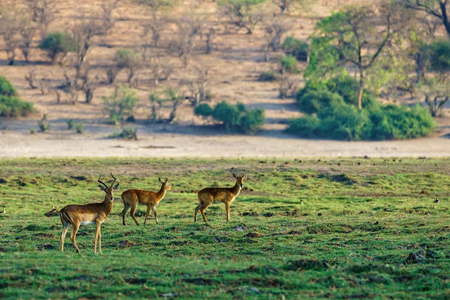Darjeeling: The Queen of the Hills in West Bengal Darjeeling, nestled in the Indian state of West Bengal, is one […]

Discovering Delhi Zoo: A Wildlife Sanctuary in the Heart of the Capital
Delhi Zoo, officially known as the National Zoological Park, is a sprawling green oasis nestled in the heart of India’s bustling capital. Established in 1959 and spread over 176 acres, the zoo offers a unique opportunity for visitors to experience wildlife and nature in an urban setting. With its diverse collection of animals and well-maintained habitats, Delhi Zoo is a popular destination for families, school groups, and wildlife enthusiasts.
A Rich Collection of Fauna
Delhi Zoo is home to over 1,500 animals representing more than 150 species from around the world. The zoo’s collection includes both native Indian species and exotic animals. Visitors can see majestic Bengal tigers, Asiatic lions, and Indian elephants, as well as the endangered one-horned rhinoceros. The zoo also houses various species of deer, bears, and leopards, offering a comprehensive view of India’s rich wildlife.
In addition to native species, the zoo features animals from different continents, including African lions, giraffes, and zebras. The aviary is another highlight, showcasing a variety of birds such as peacocks, cranes, and parrots. This diverse collection allows visitors to explore the animal kingdom in one location, making it a valuable educational resource.
Thematic Habitats and Conservation Efforts
Delhi Zoo is designed to provide naturalistic habitats for its inhabitants, aiming to mimic their native environments as closely as possible. The zoo is divided into several sections, each dedicated to different types of animals and their specific needs. For example, the tiger and lion enclosures are designed to replicate the grasslands and forests of their natural habitats, while the reptile house provides a controlled environment for various species of snakes, lizards, and turtles.
The zoo is actively involved in conservation efforts, both in situ (in the wild) and ex situ (in captivity). It participates in breeding programs for endangered species and works to raise awareness about wildlife conservation through educational programs and exhibitions. The zoo also collaborates with other national and international organizations to support conservation initiatives and protect biodiversity.
Visitor Experience and Facilities
Delhi Zoo offers a range of facilities to ensure a comfortable visit. There are well-maintained walking paths, benches, and shaded areas throughout the park. The zoo has picnic spots and food stalls where visitors can enjoy refreshments and relax. Additionally, the zoo provides educational programs and guided tours for school groups, aimed at fostering a deeper understanding of wildlife and conservation.
The zoo is also equipped with amenities such as clean restrooms, medical facilities, and a lost-and-found service. While the park is open throughout the week except Fridays, visiting early in the morning or late in the afternoon is recommended to avoid peak hours and to enjoy cooler temperatures.
Conclusion
Delhi Zoo is not just a place to see animals but a destination that offers insight into wildlife conservation and the importance of protecting natural habitats. Its diverse collection, thematic habitats, and conservation efforts make it a significant attraction in Delhi, providing educational and recreational experiences for visitors of all ages. Whether you’re a nature lover, a family looking for a day out, or someone interested in wildlife conservation, Delhi Zoo offers an enriching and enjoyable experience right in the heart of the capital.
How to Reach Delhi Zoo: A Comprehensive Guide
Delhi Zoo, officially known as the National Zoological Park, is conveniently located in the heart of Delhi, making it accessible through various modes of transportation. Here’s a guide to help you reach the zoo smoothly.
By Metro: The Delhi Metro is one of the most efficient ways to reach Delhi Zoo. You can take the Yellow Line (Line 2) of the Delhi Metro and alight at the Zoo station. From there, it’s a short walk to the main entrance of the zoo. Alternatively, you can get off at Sarai Rohilla station on the same line and take a short auto-rickshaw or cab ride to the zoo. Metro services are frequent and provide a convenient option to avoid Delhi’s traffic.
By Bus: Delhi Zoo is well-connected by the Delhi Transport Corporation (DTC) buses. Several bus routes pass near the zoo, including those that stop at the JLN Stadium or Sarai Rohilla bus stands. Look for buses on routes 10, 23, 40, and 42, among others, that have stops in proximity to the zoo. You can use the DTC website or a mobile app to find the most suitable bus route from your location.
By Auto-Rickshaw or Taxi: Auto-rickshaws and taxis are readily available throughout Delhi and provide a direct and flexible mode of transport to the zoo. Simply tell the driver you wish to go to the Delhi Zoo or National Zoological Park. It’s advisable to use metered taxis or agree on a fare before starting your journey. Ride-sharing apps like Uber and Ola also offer options for booking a cab to the zoo.
By Car: If you’re driving, Delhi Zoo is located near the Delhi Ridge on Rajaji Road. There is parking available at the zoo premises, though it may get busy on weekends and holidays. Ensure to follow the directions and traffic regulations, as the roads around the zoo can be congested during peak hours.
By Bicycle: For those who enjoy cycling, Delhi Zoo is accessible by bicycle, with several bike-friendly routes available. However, ensure you have a secure place to park your bike at the zoo’s entrance.
In summary, Delhi Zoo is accessible via metro, bus, auto-rickshaw, taxi, or personal vehicle, offering multiple convenient options for visitors. Plan your journey based on your location and preferred mode of transport to ensure a smooth and enjoyable visit.

